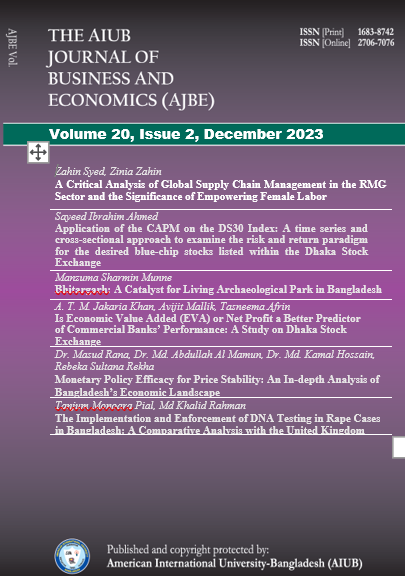Bhitargarh: A Catalyst for Living Archaeological Park in Bangladesh
Keywords:
Fortified city, Archaeological site, Community archaeology, Bhitargarh, Tourism, eco-tourismAbstract
The qualitative study aims to explore how community archaeology can be utilized to introduce the potential scopes of living archaeological park at the largest fortified settlement in Bangladesh. Open ended questionnaire was used to collect the data from the interview session with the team leader of the archaeological investigation and excavation at Bhitargarh, The study outcome reveals that the archaeological heritage tourism can be introduced at Bhitargarh as a form of living archaeological park in Bangladesh. It is found that the archaeological (tangible heritage such as archaeological relics and excavated materials) and cultural (intangible heritage such as festival, events and traditions) resources can be preserved by the community archaeology at Bhitargarh. The findings of the study implores that the community archaeology of Bhitargarh can be empowered by the active community engagement in tourism planning, decision-making and tour operation. It is suggested that the patronization of the community archaeology at Bhitargarh can be exhibited as a model for future archaeological investigation and excavation for the purpose of archaeological heritage preservation and archaeological heritage tourism in Bangladesh.
References
Ababneh, A. (2018). Tour guides and heritage interpretation: guides’ interpretation of the past at the archaeological site of Jarash, Jordan. Journal of Heritage Tourism, 13(3), 257–272. https://doi.org/10.1080/1743873X.2017.1321003
Alazaizeh, M. M., Ababneh, A., & Jamaliah, M. M. (2020). Preservation vs. use: understanding tourism stakeholders’ value perceptions toward Petra Archaeological Park. Journal of Tourism and Cultural Change, 18(3), 252–266. https://doi.org/10.1080/14766825.2019.1628243
Alazaizeh, M. M., Hallo, J. C., Backman, S. J., Norman, W. C., & Vogel, M. A. (2016). Crowding standards at Petra Archaeological Park: a comparative study of McKercher’s five types of heritage tourists. Journal of Heritage Tourism, 11(4), 364–381. https://doi.org/10.1080/1743873X.2015.1113977
Darabseh, F. M., Ababneh, A., & Almuhaisen, F. (2017). Assessing Umm el-Jimal’s Potential for Heritage Tourism. Archaeologies, 13(3), 460–488. https://doi.org/10.1007/s11759-017-9327-5
Diwan, H. D., Bhadauria, S. S., Kadwe, P., & Sanyal, D. (2021). Geologic- Geomorphic conditions, Archaeological-Architectural heritage structures and conservation of ancient hindu Malhar mud fort Chittisgarh, India. International Journal of Scientific Development and Research, 6(7), 100–108.
Dragouni, M., & Fouseki, K. (2018). Drivers of community participation in heritage tourism planning: an empirical investigation. Journal of Heritage Tourism, 13(3), 237–256. https://doi.org/10.1080/1743873X.2017.1310214
Enseñat-Soberanis, F., Frausto-Martínez, O., & Gándara-Vázquez, M. (2019). A visitor flow management process for touristified archaeological sites. Journal of Heritage Tourism, 14(4), 340–357. https://doi.org/10.1080/1743873X.2018.1529179
Fortenberry, B. R. (2021). Heritage justice, conservation, and tourism in the Greater Caribbean. Journal of Sustainable Tourism, 29(2–3), 253–276. https://doi.org/10.1080/09669582.2020.1757684
Hasan, S., Bhowmik, D., & Munne, M. S. (2022). Factors Influencing Tourist Experience : A Case Study of Adinath Temple , Maheshkhali. International Journal of Science and Business, 8(1), 1–11. https://doi.org/10.5281/zenodo.5851005
Jahan, S. H. (2019). Communities and Micro-Heritage in Bhitargarh, Bangladesh: A Case Study. In Archaeology, Cultural Heritage Protection and Community Engagement in South Asia (pp. 17–30). https://doi.org/10.1007/978-981-13-6237-8
Jha-Thakur, U., Khosravi, F., Quattrone, G., Bandyopadhyay, S., Magedera, I., & Garikipati, S. (2021). Exploring the role of strategic environmental assessment in cultural heritage tourism planning: a case study of the Srirangapatna-Mysore region in India. Impact Assessment and Project Appraisal, 39(2), 138–150. https://doi.org/10.1080/14615517.2020.1841595
Lewer, N., Lafortune-bernard, A., & Coningham, R. (2019). Community Engagement in the Greater Lumbini Area of Nepal: The Micro-Heritage Case Study of Dohani. Springer Singapore. https://doi.org/10.1007/978-981-13-6237-8
Munne, M. S., Hasan, S., & Bhowmik, D. (2021). Second Home Tourism: an Intercession for Rejuvenetion of Tourism Destination in Covid-19 Crisis. Geojournal of Tourism and Geosites, 38(4), 1265–1273. https://doi.org/10.30892/gtg.38434-768
Rahal, W. (2020). The preservation of World Archaeological Sites and promotion of touurism: Qala’at Bani Hammad (M’sila) Algeria. GeoJournal of Tourism and Geosites, 33(4), 1571–1578. https://doi.org/10.30892/gtg.
Rahman, R. U., & Siddiq, A. B. (2021). Inhabiting the World’s Largest Tropical Delta: Understanding Human-Environment Relationship from a Century-Long Archaeological Quest in Bangladesh. Dhaulagiri Journal of Sociology and Anthropology, 15, 56–64. https://doi.org/10.3126/dsaj.v15i01.41926
Rayhan, M. (2012). Bhitargarh : A Brief description of the archaeological site. Journal of the Asiatic Society of Bangladesh, 57(1), 41–60.
Shai, I., & Uziel, J. (2016). All for Archaeology and Archaeology for All : The Tel Burna Archaeology Project ’ s Approach to Community Archaeology. Journal of Community Archaeology & Heritage, 3(1), 57–69. https://doi.org/10.1080/20518196.2015.1123887
Suchana, J. J., & Munne, M. S. (2020). Potentials of Community Based Tourism Development : A Study on Maheshkhali, Bangladesh. International Journal of Science and Business, 4(5), 98–104. https://doi.org/10.5281/zenodo.3896777
Tsaravopoulos, A., & Fragou, G. (2013). Archaeological Sites as Self-Sustained Resources for Economic Regeneration : Towards the Creation of Living Archaeological Parks on the Islands of Kythera and Antikythera. Conservation and Management of Archaeological Sites, 15(1), 94–108. https://doi.org/10.1179/1350503313Z.00000000049
van den Dries, M. H. (2014). Community Archaeology in the Netherlands. Journal of Community Archaeology and Heritage, 1(1), 69–88. https://doi.org/10.1179/2051819613Z.0000000008
Westmont, V. C., & Antelid, A. (2018). The place to be: Community archaeology as a tool for cultural integration. Journal of Community Archaeology and Heritage, 5(4), 237–249. https://doi.org/10.1080/20518196.2018.1529550
Downloads
Published
How to Cite
Issue
Section
License
Copyright (c) 2024 AIUB Journal of Business and Economics

This work is licensed under a Creative Commons Attribution-NonCommercial 4.0 International License.

